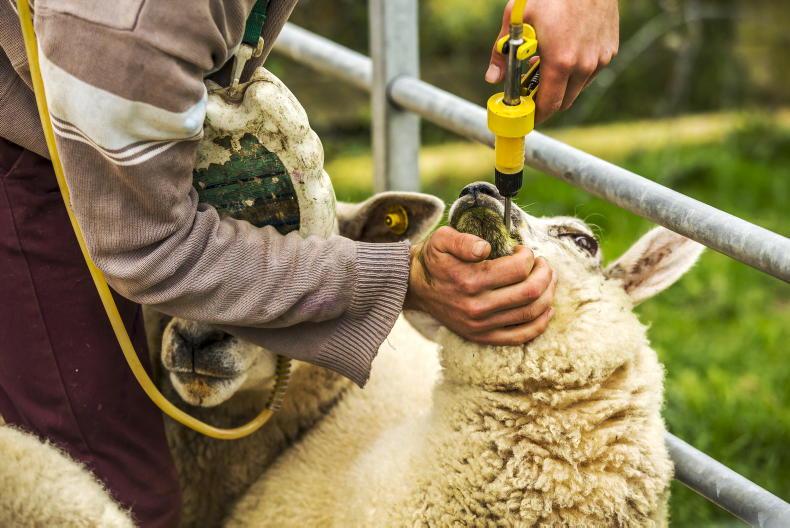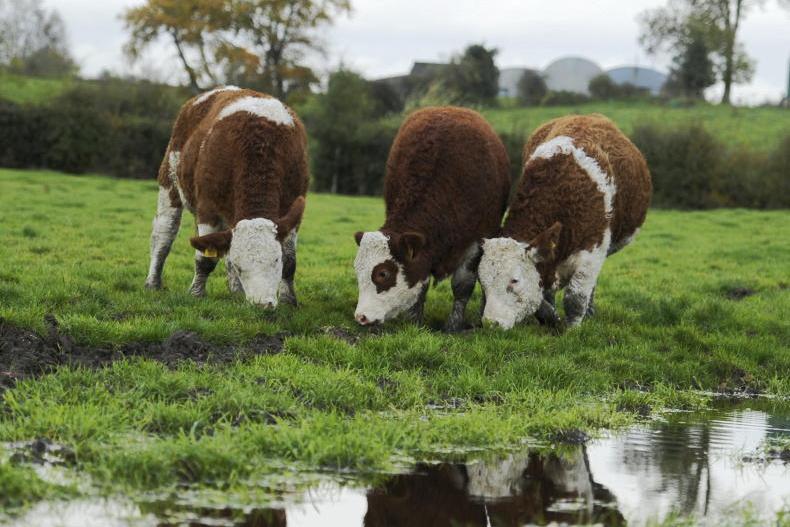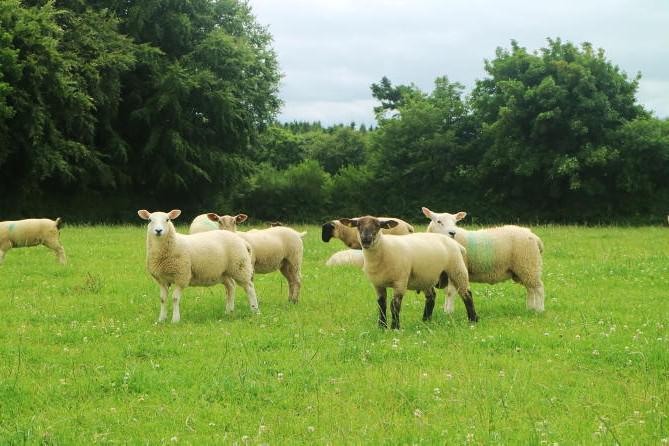Management tasks on the programme farms are now focused on drafting lambs, selecting replacements and getting on top of flock health.
With sheep been gathered for clipping or weaning, it may seem practical to use such opportunities to treat lambs for worms.
However, as anthelmintic resistance is growing on sheep farms, worm treatments should be based more on need, rather than simply fitting in with routine handling practices.
Fecal egg counting (FEC) is still met with low levels of uptake on sheep farms. Yet it can give a clear indication on whether a dose is required, as well the efficacy of treatments and the products used.
Dosing on evidence
On the programme farms, FEC has been used to good effect for timing worm treatments. For example, on Trevor Nixon’s farm in Fermanagh, samples were taken from lambs in late June.
Lambs sampled included animals that were soiled around the hindquarter and tail along with lambs with a clean fleece.
Going by visual appearance, the logical thinking pointed to a worm dose being required given the number of lambs starting to show a soiled coat.
However, the FEC samples indicated that worm burdens, namely nematodirus and stronglyes, were at low to moderate levels in late June.
As such, a worm drench was not required at this point in time. Instead, further FEC samples will be taken in the coming weeks to see if egg counts are rising.
If so, a treatment will then be given. Using FEC samples to monitor worm levels and target treatment at the right time means Trevor will get a far better worm kill when he does dose lambs.
Had a dose been administered in late June, based on visual appearance, the treatment would have been effective. But given the earlier than required treatment, the residual cover period may not last long enough to control worms through the summer. As such, a follow-up drench may well have been required in late July.
Risk period
Grazing conditions have been relatively settled across the farms, with dry weather allowing higher grass utilisation.
Dry conditions have helped to curtail worm burdens on grass. However, following rain over the weekend and early part of this week, worm populations will quickly multiply.
Therefore, flockowners should be alert to worm burdens in the next fortnight. FEC counts are worth considering and can be carried out through most local vets or farm advisers.
Five tips for improved worm control in lambs
There is little point in trying to time worm treatment properly if the dosing technique is poorly carried out.
Underdosing is just as bad as overdosing when it comes to worms building up resistance.
Where flockowners intend on worming lambs in the coming weeks, outlined are five tips that can help improve dosing methods.
1 Weighing lambs when dosing
Every sheep farm has a weighbridge for drafting lambs, so why not make use of if when dosing. All too often, lambs are gathered for worming, yet the dosing rate is based on an estimated weight.
There can be a big variation in lamb liveweight within a group depending on gender, breed, age and conformation.
Running 10 or 12 lambs per group over the bridge will give a far better handle on liveweight. This means a more accurate dosing rate can be given.
Split bigger lamb groups to reduce the variation in weight. It may take more time at the outset. But as the race will be filled with even-sized lambs, you won’t have to stop and re-calibrate dosing rates as often.
2 Make sure the dosing gun is working and calibrated
If using an oral drench, always check that the dosing gun is working properly and regularly recalibrate when in use.
Also, make sure the gun has been washed after the previous use. If not, the last drench may have dried out. This residue can partly block the intake and exit points on the gun.
Make sure the gun refills properly after each discharge. Holding the gun facing downwards will help it refill without air bubbles.
3 Restraining sheep
Make sure lambs are properly restrained in a secure race before drenching. This makes it easier to hold lambs for dosing, making it safer for the farmer compared to dosing animals in a group pen.
4 Dosing
Hold lambs below the jaw and lift the mouth upwards. The dosing gun should be placed over the molar teeth and over the back of the tongue to ensure the drench is properly swallowed. If an injection-based wormer is used, make sure to read the instructions. A subcutaneous injection should be given under the skin. Use the correct size of needle and administer on the animal’s neck. An intra-muscular injection needs a longer needle to deliver the wormer into the muscle. Always massage the injection site after treatment.
5 Post-treatment
Once lambs have been dosed, moving them to clean grass or returning animals to the same field they were grazing always generates debate. Moving directly to clean grass, such as silage aftermath or a reseed, means that any resistant worms will be shed on this pasture. Without competition from other worms, the more resistant strains can multiply and build.
In contrast, most advice recommends returning lambs to the paddocks they grazed before dosing. After a four- to five-day period, lambs can then be moved to clean grass.
Any worms surviving the dose will be shed on the pasture with multiple worm burdens present, slowing down the growth of strains that are possibly resistant to certain products.
Read more
Managing a 1,200-head pedigree ewe flock commercially in Scotland
Thrive: keeping calves on target at grass mid-summer
Management tasks on the programme farms are now focused on drafting lambs, selecting replacements and getting on top of flock health.
With sheep been gathered for clipping or weaning, it may seem practical to use such opportunities to treat lambs for worms.
However, as anthelmintic resistance is growing on sheep farms, worm treatments should be based more on need, rather than simply fitting in with routine handling practices.
Fecal egg counting (FEC) is still met with low levels of uptake on sheep farms. Yet it can give a clear indication on whether a dose is required, as well the efficacy of treatments and the products used.
Dosing on evidence
On the programme farms, FEC has been used to good effect for timing worm treatments. For example, on Trevor Nixon’s farm in Fermanagh, samples were taken from lambs in late June.
Lambs sampled included animals that were soiled around the hindquarter and tail along with lambs with a clean fleece.
Going by visual appearance, the logical thinking pointed to a worm dose being required given the number of lambs starting to show a soiled coat.
However, the FEC samples indicated that worm burdens, namely nematodirus and stronglyes, were at low to moderate levels in late June.
As such, a worm drench was not required at this point in time. Instead, further FEC samples will be taken in the coming weeks to see if egg counts are rising.
If so, a treatment will then be given. Using FEC samples to monitor worm levels and target treatment at the right time means Trevor will get a far better worm kill when he does dose lambs.
Had a dose been administered in late June, based on visual appearance, the treatment would have been effective. But given the earlier than required treatment, the residual cover period may not last long enough to control worms through the summer. As such, a follow-up drench may well have been required in late July.
Risk period
Grazing conditions have been relatively settled across the farms, with dry weather allowing higher grass utilisation.
Dry conditions have helped to curtail worm burdens on grass. However, following rain over the weekend and early part of this week, worm populations will quickly multiply.
Therefore, flockowners should be alert to worm burdens in the next fortnight. FEC counts are worth considering and can be carried out through most local vets or farm advisers.
Five tips for improved worm control in lambs
There is little point in trying to time worm treatment properly if the dosing technique is poorly carried out.
Underdosing is just as bad as overdosing when it comes to worms building up resistance.
Where flockowners intend on worming lambs in the coming weeks, outlined are five tips that can help improve dosing methods.
1 Weighing lambs when dosing
Every sheep farm has a weighbridge for drafting lambs, so why not make use of if when dosing. All too often, lambs are gathered for worming, yet the dosing rate is based on an estimated weight.
There can be a big variation in lamb liveweight within a group depending on gender, breed, age and conformation.
Running 10 or 12 lambs per group over the bridge will give a far better handle on liveweight. This means a more accurate dosing rate can be given.
Split bigger lamb groups to reduce the variation in weight. It may take more time at the outset. But as the race will be filled with even-sized lambs, you won’t have to stop and re-calibrate dosing rates as often.
2 Make sure the dosing gun is working and calibrated
If using an oral drench, always check that the dosing gun is working properly and regularly recalibrate when in use.
Also, make sure the gun has been washed after the previous use. If not, the last drench may have dried out. This residue can partly block the intake and exit points on the gun.
Make sure the gun refills properly after each discharge. Holding the gun facing downwards will help it refill without air bubbles.
3 Restraining sheep
Make sure lambs are properly restrained in a secure race before drenching. This makes it easier to hold lambs for dosing, making it safer for the farmer compared to dosing animals in a group pen.
4 Dosing
Hold lambs below the jaw and lift the mouth upwards. The dosing gun should be placed over the molar teeth and over the back of the tongue to ensure the drench is properly swallowed. If an injection-based wormer is used, make sure to read the instructions. A subcutaneous injection should be given under the skin. Use the correct size of needle and administer on the animal’s neck. An intra-muscular injection needs a longer needle to deliver the wormer into the muscle. Always massage the injection site after treatment.
5 Post-treatment
Once lambs have been dosed, moving them to clean grass or returning animals to the same field they were grazing always generates debate. Moving directly to clean grass, such as silage aftermath or a reseed, means that any resistant worms will be shed on this pasture. Without competition from other worms, the more resistant strains can multiply and build.
In contrast, most advice recommends returning lambs to the paddocks they grazed before dosing. After a four- to five-day period, lambs can then be moved to clean grass.
Any worms surviving the dose will be shed on the pasture with multiple worm burdens present, slowing down the growth of strains that are possibly resistant to certain products.
Read more
Managing a 1,200-head pedigree ewe flock commercially in Scotland
Thrive: keeping calves on target at grass mid-summer










SHARING OPTIONS